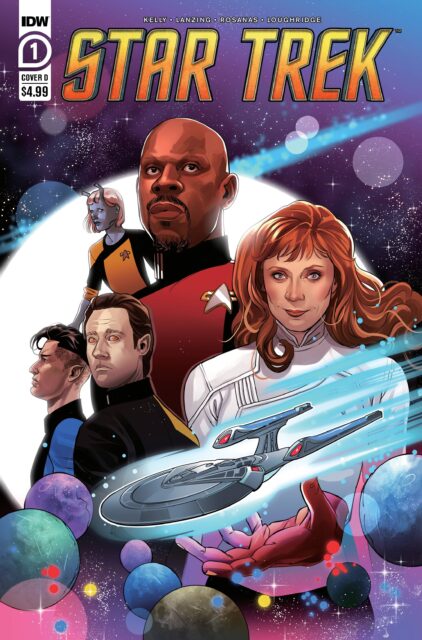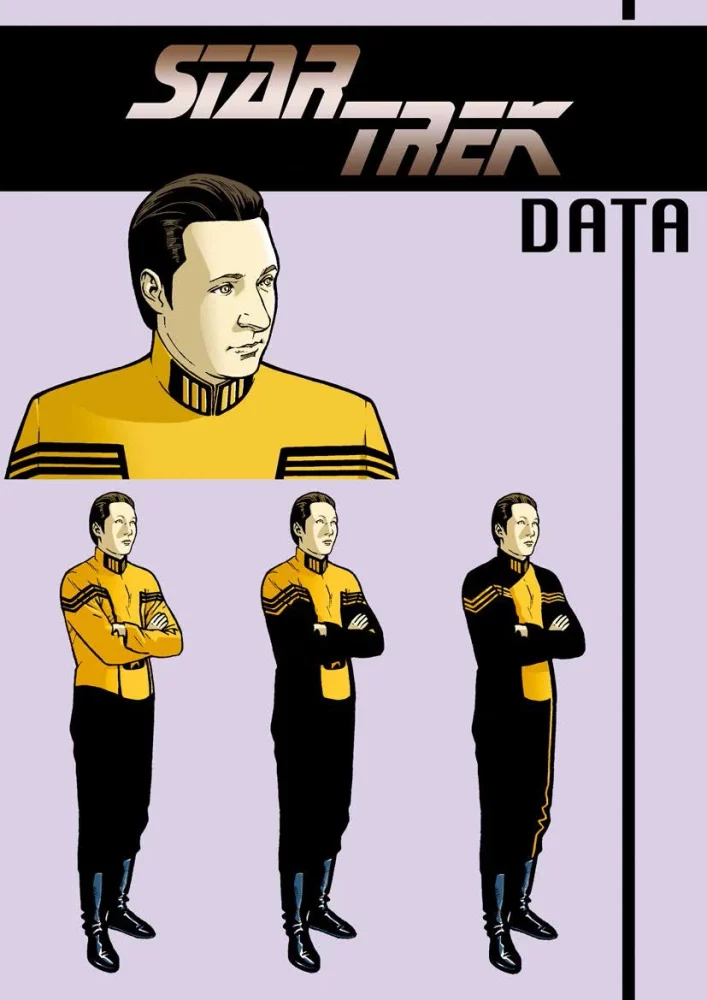“All good things must come to an end… and then begin again.”
And so begins a new era of IDW’s Star Trek comics written by Collin Kelly and Jackson Lanzing, art by Ramon Rosanas, Lee Loughridge, and Clayton Cowles; this new series is an extension of the Deep Space Nine, and Next Generation, with characters from the original series and Voyager. There are even nods to the new Paramount series. Basically, it’s got the Star Trek cannon covered.
Set three years after the events of the Deep Space Nine TV finale, Captain Benjamin Sisko, war hero and emissary to the Prophets, returns from the celestial temple with a mission from the Gods. Something is wrong in the universe that even the all-powerful temporal anomalies, The Prophets, can’t stop. They need a corporeal being who can attract the best that Star Fleet has to offer. They need The Sisko.

Re-introductions
The opening of this first issue of Star Trek reminds the reader where Sisko was when last we saw him; inside the Celestial Temple. Then, the script sets up, albeit in the usual Prophet enigma-type way, what is to come in this issue while also paying homage to the original concept of the Star Trek ethos: To Go Where No One Has Gone Before.
This opening scene is an audience grabber. It instantly lets you know where you are within continuity and evokes all the feelings for characters we haven’t seen for quite a while. As a big fan of DS9, it is an inspiring moment to have the characters back and be allowed to see what happened to them after What You Leave Behind. Although, this comic series takes a different approach than the television series. It moves the central character away from the static hub of the station and gives him a spaceship and a crew. Hence the comic is called Star Trek and not Deep Space 9.
The writers, Kelly and Lanzing, have mined the vast array of Star Trek lore to crew the new Discovery class ship that Sisco will captain. There are several fan favorites from several different iterations of the show. Plus, a host of new, intriguing characters who instantly feel like regular cast members and not nameless extras to fill the bridge. It’s a testament to Kelly and Linzing’s writing that they can make the new characters full of life in the limited page space they have because a lot happens in this first issue. The narrative doesn’t hang around, so it would be easy to rely on established characters to tell the story, but every character, new and old, has a logical reason for being included.
The use of Picard is a prime example. The Next Generation captain himself even questions why Sisko has gone to see him, and the reply is simple, obvious, and rooted in the emotional histories that both of the captains share. The two-page scene is a beautiful moment, superbly written and excellently illustrated. It is pure Star Trek.

To Boldly Go
Rosanas uses fine lines to create the characters and locations within the Star Trek world. This style is reminiscent of the Gold Key Comics original Star Trek comics, drawn by Alberto Giolitti. Still, it is evident that Rosanas has studied the characters closely because they are instantly recognizable. Rosanas also has a flair for the dramatic, as witnessed by Sisko in the Wormhole and the arrival of Data. These full-page spreads contain the least amount of narrative information but provide big moments that leap out of the comic and stick in your memory. In every Star Trek movie, there is a slow, dramatic reveal of the Enterprise that takes the audience’s breath away; Rosanas manages to pull off the same emotional impact with several big reveals throughout this comic.
One aspect of the comic that adds drama and depth to the universe is the coloring. Whether it’s the subtle, swirling cosmos throughout the darkness of space or the artificial lighting within the star ships, Loughridge creates an air of wonder on each page and produces a magical contrast between the technical world of the Federation and the unexplained spaces of the universe. There is a constant visual dynamic between the mechanical and the natural, and the characters slip in between, bridging the gap.
Contrast is an excellent word to use when talking about Cowles’ lettering because his layouts for the word balloons allow moments in the script to shine by leaving panels empty of speech and then making it feel like the next panel is packed with text. This creates urgency in the speech but also awkwardness, nervousness, and strength, depending on which character is speaking.
Cowles is very good at laying out naturally flowing conversations that make it so easy for the reader to follow. He instantly gets you into the flow of the back-and-forth between characters, leading you through the scene. A prime example of this is near the beginning, as Sisko returns to the universe. The page is devoid of images, and the reader experiences only the voices, just as Sisko does. Within the first four balloons, equivalent to the first panel, the speech establishes who the characters are and from that point on, you have their voices in your head. Cowles then leads you through the empty, frame-less panels but at no point do you lose track of who is speaking. The flow is obvious and effortless to read.

Conclusion
Star Trek is a popular franchise at the moment, and there are numerous television series and comic books doing the rounds. Some adaptations have been more successful than others at capturing the Star Trek vision. The recent Year Five series was a blinding success, whereas the Discovery tie-ins have been less impressive. There is often a desire with franchise comics to throw as many references in as possible, and this ends up feeling like the creators are trying to prove they have done their homework. More often than not, this kind of approach to storytelling fails. However, in the case of this new Star Trek comic, each of the characters (with possibly one exception) has a reason for being there. They serve a narrative function beyond pleasing the fans. It makes sense for Sisko to visit Picard and for Data to be assigned. Of course, Beverly Crusher would want to be the medical officer on a ship with a Captain who has spent three years existing outside of the universe; after all, it might help her understand what happened to her son. The choices made by the creative team, on who to use, where to set it, etc., make perfect sense within the narrative and, as a result, make the story engrossing. At no point is the reader thrown out of the comic by an awkward reference or name-drop. It all has a glorious purpose and tells a magnificent story.
IDW has hit upon the perfect mix of nostalgia and modern storytelling in this new Star Trek series, just like Year Five before it; I can’t wait to see where this old/new crew takes us.

